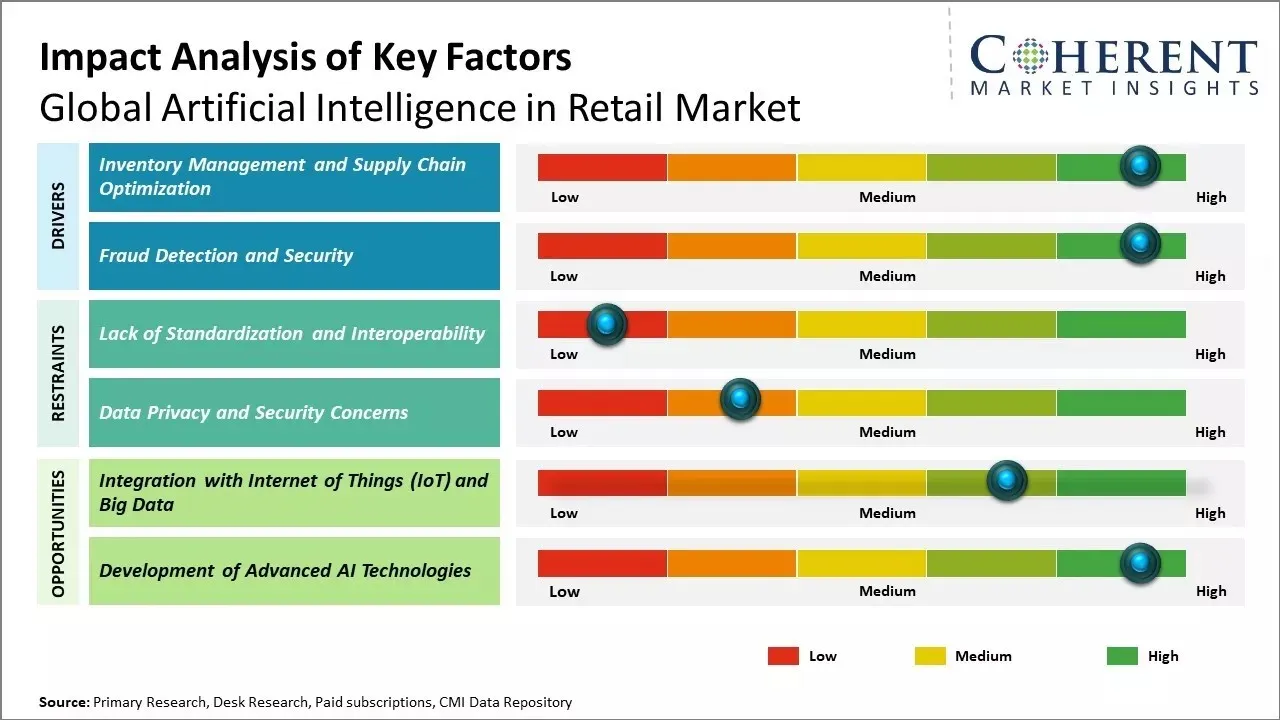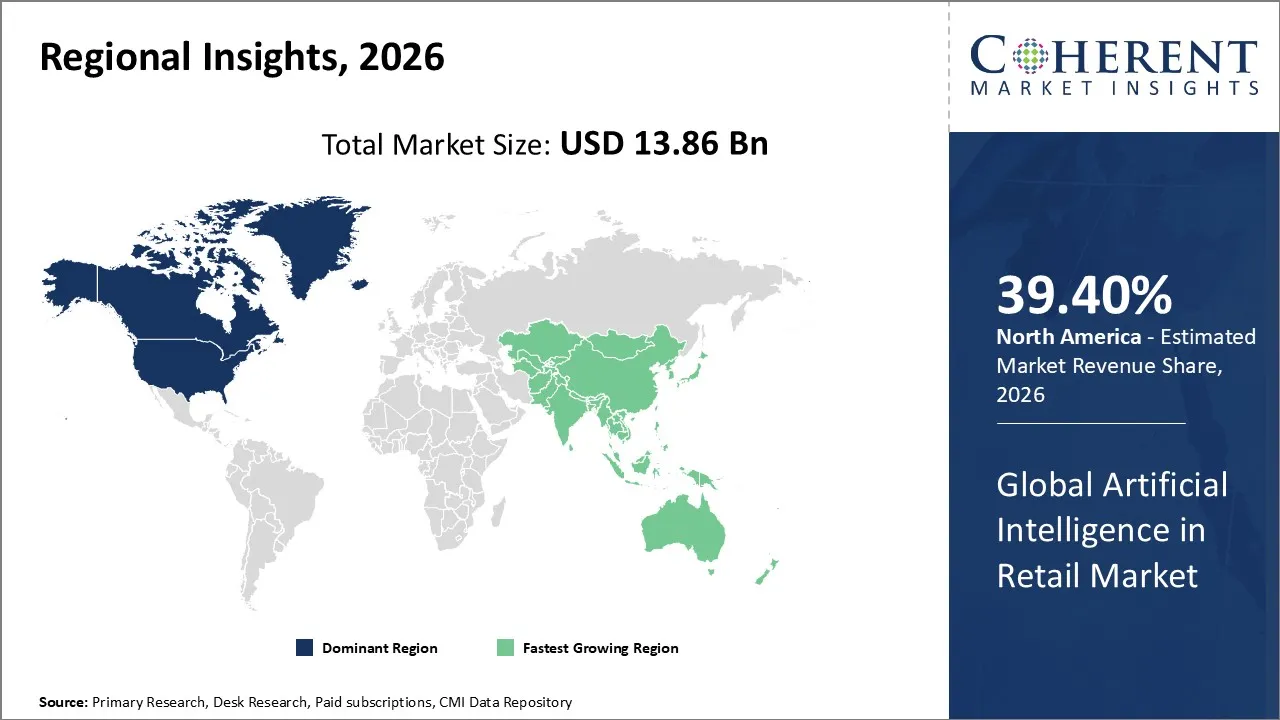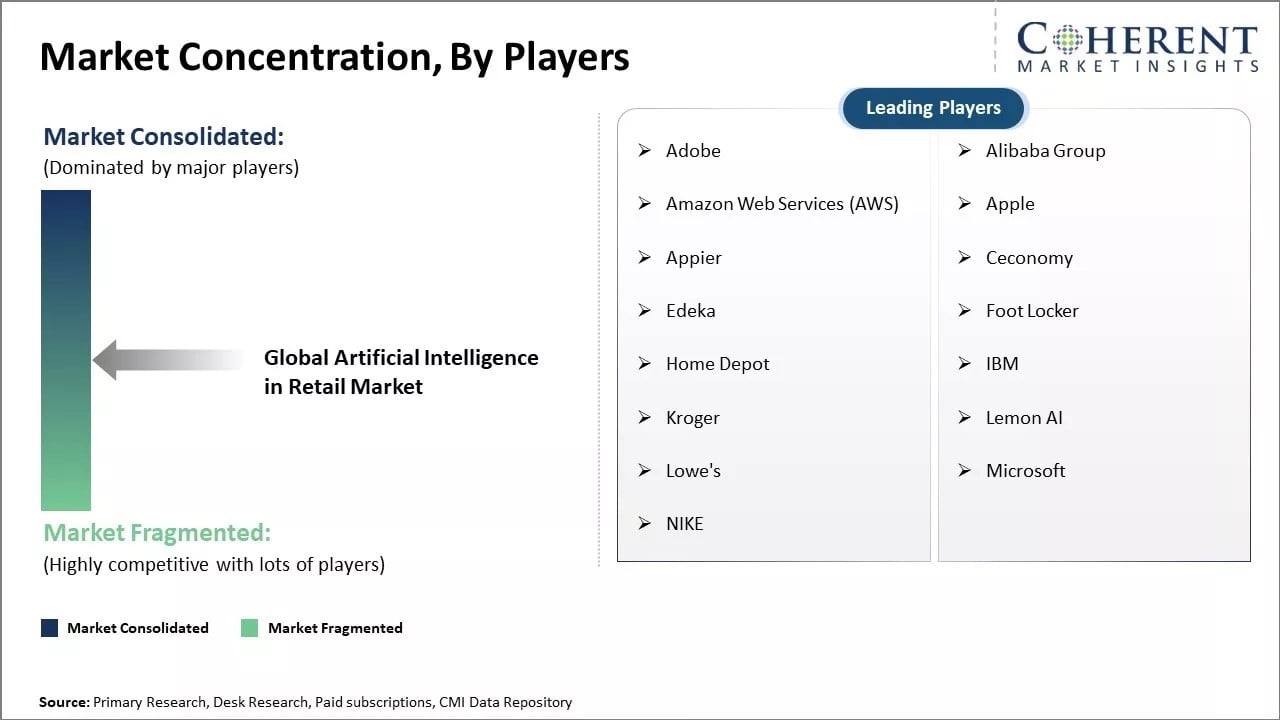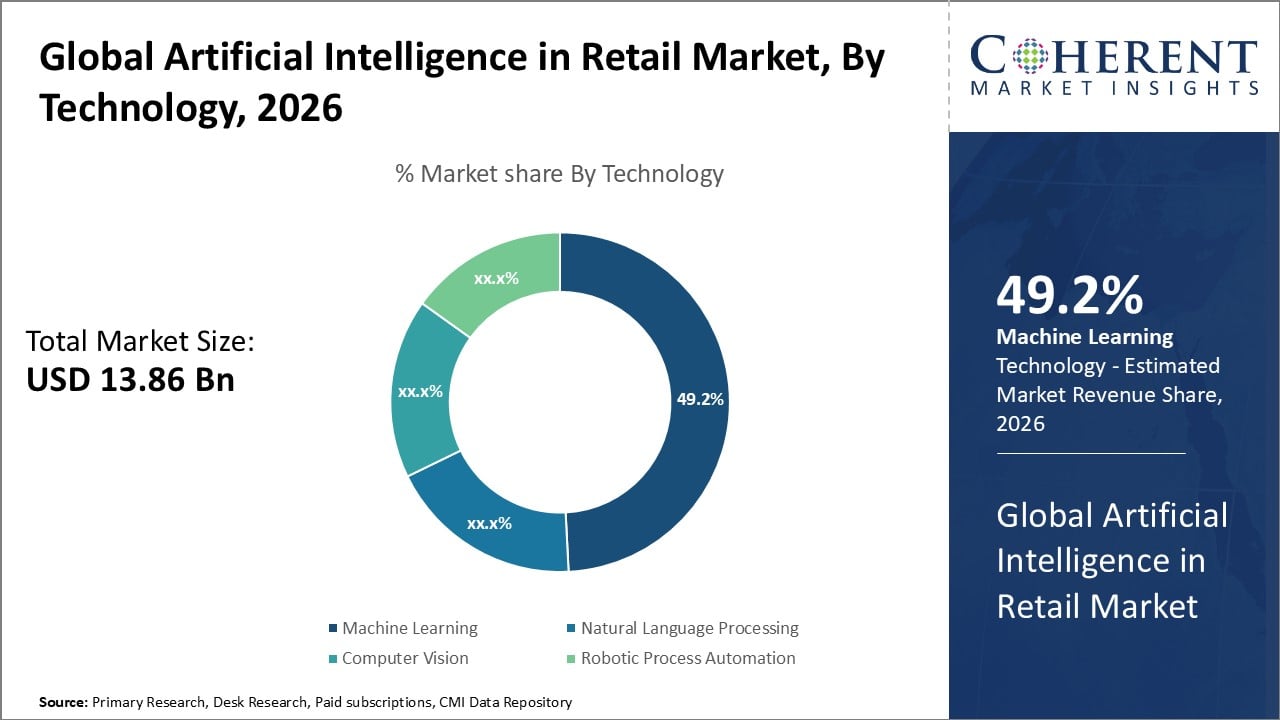Artificial Intelligence in Retail Market Size and Trends- (2026-2033)
The Global Artificial Intelligence in Retail Market is estimated to be valued at USD 13.86 Bn in 2026 and is expected to reach USD 97.83 Bn by 2033, exhibiting a compound annual growth rate (CAGR) of 32.2% from 2026 to 2033.
Key Takeaways
- Based on Technology, the Machine Learning segment is projected to account for 49.2% share in 2026, due to the rise of personalized customer experiences.
- Based on Application, the Personalized Recommendations segment is expected to hold 32% share of the market in 2026, driving sales, loyalty, and seamless shopping.
- Based on End User, the E-commerce segment is expected to lead the market with 58.3% share in 2026, driven by embracing digital transformation.
- Based on Region, North America is set to lead the artificial intelligence in retail market with 39.4% share in 2026. While, Asia Pacific is anticipated to be the fastest growing region.

To learn more about this report, Download Free Sample
Market Overview
Artificial intelligence is helping retailers improve operations across key areas such as merchandising and supply chain planning. Techniques like machine learning and deep learning are enabling personalized product recommendations and predictive analytics.
Retailers are deploying AI-powered solutions such as computer vision, chatbots, and predictive analytics to enhance customer experience. AI technologies allow retailers to analyze shopping patterns and predict demand more accurately. They are also assisting in reducing inventory costs and improving supply chain efficiencies. The growing customer demand for personalized experiences is further driving retailers to adopt AI at scale across their operations.
Current Events and Its Impacts on the Artificial Intelligence in Retail Market
|
Current Event |
Description and its Impact |
|
European Union AI Act Implementation and Global Regulatory Cascade |
|
|
Breakthrough AI Technologies and Industry Consolidation |
|
Uncover macros and micros vetted on 75+ parameters: Get instant access to report
Is AI Daily Use and Omnichannel Growth Redefining Retail Adoption Trends?
- Daily Use of AI
- 77% of eCommerce professionals use AI daily, confirming its role as essential infrastructure.
- AI is embedded in everyday retail workflows: product recommendations, fraud detection, dynamic pricing, and customer service chatbots.
- Omnichannel Retail Growth
- Omnichannel retail is the fastest-growing application, integrating AI across online platforms, mobile apps, and physical stores.
- AI enables personalized shopping journeys, ensuring consistent experiences whether customers shop online, in-store, or via mobile.
- Retailers using AI-driven omnichannel strategies report 20–30% higher customer retention rates compared to single-channel approaches.
- Revenue & Efficiency Impact
- Retailers leveraging AI experience 5–15% annual revenue growth while reducing operational costs by up to 30%.
- AI-driven inventory optimization reduces stockouts by 50%, improving customer satisfaction and boosting sales.
- Predictive analytics in supply chains cut logistics costs by 10–20%.
Artificial Intelligence in Retail Market Insights, By Technology - The Machine Learning Segment Dominates Due to the Rise of Personalized Customer Experiences
In terms of technology, the machine learning segment is estimated to hold 49.2% share of the market in 2026 owing to its capability to analyze large amounts of customer data. Machine Learning algorithms can scan purchasing patterns, browsing history, product reviews, and more to gain deep customer insights. With these insights, machine learning powers personalized product recommendations and experiences. It understands customer preferences, priorities and what they are likely to purchase next.
For instance, in March 2025, the new Interests feature from Amazon uses generative AI and machine learning to make shopping more personal, which changes the way people shop. Customers share their needs in everyday language, and the system keeps an eye on the inventory for products that fit those needs. This new feature makes it easier to find products, do research, and get personalized recommendations, changing retail intelligence with adaptive personalization.
Artificial Intelligence in Retail Market Insights, By Application - The personalized recommendations lead is driving sales, loyalty, and seamless shopping
In terms of application, the personalized recommendations segment is estimated to hold 32% share of the market in 2026, driven by directly drives sales, enhances customer satisfaction, and builds loyalty. By analyzing browsing behavior, purchase history, and preferences, AI tailors product suggestions to individual shoppers. This boosts conversion rates, reduces decision fatigue, and creates seamless, engaging shopping experiences that retailers prioritize for growth.
For instance, in Septmber 2025, Salesforce and Orra Fine Jewelry used AI-driven personalization to change the way jewelry is sold. The system makes personalized suggestions across all channels by looking at customers' preferences, behaviors, and purchase history. This new feature makes shopping more fun, increases engagement, and builds loyalty. It shows how AI changes luxury
Artificial Intelligence in Retail Market Insights, By End User - The E-Commerce Segment's Growth Driven by Embracing Digital Transformation
In terms of End User, the E-commerce segment is estimated to hold 58.3% share in 2026 owing to its fully digital business model. However, brick-and-mortar stores are increasingly leveraging AI just to survive in this new era. Computer vision installed in physical stores can detect inventory levels, perform real-time pricing and planogram compliance checks to keep shelves fully stocked with correctly priced items. It also provides timely alerts about spills, low levels, and misplaced products. Computer Vision gives brick-and-mortar retailers the same level of visibility that E-commerce giants enjoy through Machine Learning and NLP. Robotic Process Automation (RPA) executes repetitive administrative tasks to reduce costs.
For instance, In January 2024, Google Cloud, a leading provider of cloud computing services, launched several new AI-powered technologies to help retailers personalize online shopping experiences, modernize operations, and transform in-store technology rollouts. As part of these innovations, Google Cloud enhanced its flagship search technology for retailers with large language model capabilities, enabling shoppers to more easily find and discover products. These new offerings aim to provide retailers with practical and powerful tools to fuel growth and evolve customer experiences in an increasingly competitive landscape.
Regional Insights

To learn more about this report, Download Free Sample
North America Artificial Intelligence in Retail Market Analysis & Trends
North America has established itself as the dominant region in the global artificial intelligence in retail market with an estimated 39.4% share in 2026. This can be attributed to heavy investments being made by major tech companies like Microsoft, IBM, Nvidia, C3.ai, etc. as well as retailers based in the U.S. and Canada to integrate AI-based technologies across their operations. Moreover, the presence of several AI startup incubators and accelerators in the region has fostered innovation.
For instance, in December 2025, Fabrique partnered with Gensmo to bring AI-powered styling to New York during the busiest shopping time of the year. The platform uses AI to give customers personalized fashion advice, get them more involved, and make it easier to find products. This partnership shows how AI is changing retail by making shopping experiences smarter and more personalized, with effects all over the world.
Asia Pacific Artificial Intelligence in Retail Market Analysis & Trends
The Asia Pacific region has emerged as the fastest growing market for artificial intelligence in retail. Rapid digitalization of the retail sector and growing penetration of internet and smartphones are driving regions growth. Countries like China, India, and Japan house a massive consumer base that is highly receptive to innovative AI-enabled technologies.
For instance, in December 2025, Watsons Water launched its first line of AI-designed products in Hong Kong. These products combine cutting-edge technology with famous local landmarks. The AI-driven packaging demonstrates the way AI is changing retail branding, making shopping more fun for customers, strengthening cultural identity, and increasing engagement in Asia-Pacific's competitive market during the busiest shopping season.
Artificial Intelligence in Retail Market Outlook Country-Wise
The U.S. Artificial Intelligence in Retail Market Trends
The U.S. retail market needs artificial intelligence by 2026 since e-commerce is growing, customers want personalized experiences, and omnichannel shopping is becoming more popular. AI makes it easier to keep track of inventory, stop fraud, and connect with customers. Retailers use AI to make their businesses more efficient, improve their supply chains, and offer smooth, safe, and personalized shopping experiences across the country.
For instance, in November 2025, Google launched AI-powered shopping to the US, using generative AI to improve retail search and product discovery. The technology gives consumers a personalized suggestions, better search results, and better shopping experiences. This is an important development toward using AI in retail, which will change how customers interact with stores and how visible they are in the U.S. market.
China Artificial Intelligence in Retail Market Trends
Since e-commerce is growing quickly, mobile-first consumers are becoming more common, and the government is backing AI innovation, China's retail market needs AI by 2026. Retailers use AI to make shopping more personal, improve supply chains, and get customers more involved. Adoption is driven by more competition and tech-savvy shoppers, which makes AI necessary for efficiency and market leadership.
For instance, in October 2024, Huawei launched its Smart Retail Solution at HUAWEI CONNECT 2024 in Shanghai, which was all about the way AI can help retail grow. The project uses AI to make operations run more smoothly, improve supply chains, and make customers happier. Generative AI speeds up the development of new products, and customized retail models improve personalization, efficiency, and resilience across the board.
Market Report Scope
Artificial Intelligence in Retail Market Report Coverage
| Report Coverage | Details | ||
|---|---|---|---|
| Base Year: | 2025 | Market Size in 2026: | USD 13.86 Bn |
| Historical Data for: | 2020 To 2024 | Forecast Period: | 2026 To 2033 |
| Forecast Period 2026 to 2033 CAGR: | 32.2% | 2033 Value Projection: | USD 97.83 Bn |
| Geographies covered: |
|
||
| Segments covered: |
|
||
| Companies covered: |
Adobe, Alibaba Group, Amazon Web Services (AWS), Apple, Appier, Ceconomy, Edeka, Foot Locker, Home Depot, IBM, Kroger, Lemon AI, Lowe's, Microsoft, and NIKE |
||
| Growth Drivers: |
|
||
| Restraints & Challenges: |
|
||
Uncover macros and micros vetted on 75+ parameters: Get instant access to report
Artificial Intelligence in Retail Market Driver
How is artificial intelligence improving inventory management and supply chain optimization in the retail market?
One of the key drivers of artificial intelligence adoption in the retail industry is the potential it shows to optimize inventory management and supply chain processes. With AI, retailers can now analyze past sales data patterns and use predictive analytics to forecast consumer demand trends and purchase behavior more accurately. This helps them in planning inventory levels according to anticipated sales and avoid situations of stockouts as well as overstocking. With precise demand forecasting, retailers save huge costs associated with holding excess inventory, disposing unsold items, and lost sales opportunities due to stockouts.
AI applications like computer vision and machine learning algorithms are also enabling retailers to optimize supply chain operations from sourcing to distribution. Tools like inventory tracking using image recognition and predictive analytics for replenishment automatically identify low stock items on shelves and replenish them before running out. This enhances on-shelf availability and improves customer satisfaction without needing manual checks. Similarly, demand forecasts combined with the optimization of transportation routes is reducing logistics costs for retailers significantly. Systems can now calculate the most efficient routes by consolidating deliveries and maximizing truck capacity utilization.
How is artificial intelligence enhancing fraud detection and security in the retail market?
As online shopping has proliferated, problems of payment frauds and identity thefts have also increased exponentially. Traditional rule-based and manual methods of fraud detection are no longer effective against the evolving tactics of sophisticated fraudsters. This is a key challenge for the retail industry where even a single fraudulent transaction can dent customer confidence and profit margins. Advanced AI solutions deploying techniques such as machine learning, deep learning, and neural networks are emerging as a potent weapon against payment frauds. Systems can analyze a massive volume of transaction data, detect complex patterns, and spot even subtle anomalies that human analysts may miss.
Machine learning algorithms can consider a wide range of customer attributes as well as device parameters to compare a transaction against known risk profiles. This helps determine if an online purchase, return, or exchange request is legitimate or potentially fraudulent within real-time. AI tools are also capable of continuous learning from new legitimate and fraudulent data to improve detection accuracy over time. Integrated with appropriate security measures, AI significantly strengthens the frontline defense for retailers and payment gateways against financial and identity thefts in the digital era. This protects businesses as well as enhances safe shopping experience for the customers.
Artificial Intelligence in Retail Market Opportunity
How will AI integration with IoT and Big Data drive retail market growth?
One major opportunity for the global artificial intelligence in retail market lies in deeper integration of AI with Internet of Things (IoT) devices and big data analytics tools. Retailers are increasingly adopting IoT sensors to gather real-time customer insight and operational intelligence from physical store locations. AI has the capability to analyze huge volumes of data from these IoT deployments and customer transactions to generate valuable patterns. By fusing AI with IoT data streams and big data, retailers can gain unprecedented visibility into consumer behaviour, predict demand trends, optimize inventory, recommend personalized offers, and enhance overall shopping experience. AI combined with IoT also enables new areas like predictive maintenance of store equipment, advanced computer vision powered store operations, and drone-based warehouse management. The mergers of these technologies will be a key driver of innovation and growth in the AI retail market in the coming years.
Market Concentration and Competitive Landscape

To learn more about this report, Download Free Sample
Analyst Opinion (Expert Opinion)
- Artificial intelligence in retail is becoming a key part of the data-driven transformation of retail, with a rising number of stores using it in merchandising, operations, and customer engagement. According to industry surveys, almost 75–80% of retailers around the world have used AI in at least one area of their business. This shows that AI is moving from pilot use to full-scale deployment. AI-enabled retail solutions are most commonly used for predicting demand, personalizing promotions, optimizing prices, and automating customer service.
- Data-driven insights show that AI-based demand forecasting systems can make inventory more accurate by 20–30%, which brings down on stockouts and excess inventory. More and more retailers are using computer vision and analytics tools to keep an eye on shelves, stop losses, and analyze foot traffic in stores. These tools have been shown to make stores run more efficiently. Chatbots and virtual assistants now handle a significant amount of customer interactions, which speeds up responses by more than 40% in many omnichannel retail settings.
- North America is still a major place for adoption as it has good digital infrastructure and an abundance of money is being put into retail technology. In Asia Pacific, on the other hand, adoption is happening faster via large e-commerce platforms and consumers who use their phones first. Cloud-based AI platforms are the most popular for implementation as they can grow and are easier to integrate at first. Overall, AI is changing the way retailers make decisions by giving them predictive insights, automating operations, and creating hyper-personalized shopping experiences. This makes AI a long-term competitive advantage in the global retail ecosystem.
Recent Developments
- In November 2025, Instacart released new AI tools for grocery stores that made shopping easier and better for customers. The tools give personalized suggestions, help with inventory management, and make stores run more smoothly. This project shows how AI is changing the grocery business by making it more convenient, smarter, and more engaging for customers.
- In October 2025, Walmart collaborated with OpenAI to make shopping in the US more AI-friendly. Walmart uses generative AI to improve personalization, product discovery, and customer engagement in both its online and physical stores. This project shows how AI is changing the retail industry by making shopping smarter, easier, and more convenient for people all over the country.
- In April 2025, TCS worked with Google Cloud to speed up the use of AI in the retail industry. The partnership uses cloud-based AI to make customers happier, make supply chains more efficient, and make operations more flexible. Retailers can innovate and stay competitive in the changing global market by adding AI solutions, which give them personalization, efficiency, and scalability.
Market Segmentation
- By Technology Insights (Revenue, USD Bn, 2026 - 2033)
-
- Machine Learning
- Natural Language Processing (NLP)
- Computer Vision
- Robotic Process Automation (RPA)
- By Application Insights (Revenue, USD Bn, 2026 - 2033)
- Personalized Recommendations
- Inventory Management
- Customer Service Chatbots
- Fraud Detection
- Pricing Optimization
- By End User Insights (Revenue, USD Bn, 2026 - 2033)
- E-commerce
- Brick-and-Mortar Stores
- Wholesalers
- By Regional Insights (Revenue, USD Bn, 2026 - 2033)
- North America
- U.S.
- Canada
- Latin America
- Brazil
- Argentina
- Mexico
- Rest of Latin America
- Europe
- Germany
- U.K.
- Spain
- France
- Italy
- Russia
- Rest of Europe
- Asia Pacific
- China
- India
- Japan
- Australia
- South Korea
- ASEAN
- Rest of Asia Pacific
- Middle East
- GCC Countries
- Israel
- Rest of Middle East
- Africa
- South Africa
- North Africa
- Central Africa
- North America
- Key Players Insights
- Adobe
- Alibaba Group
- Amazon Web Services (AWS)
- Apple
- Appier
- Ceconomy
- Edeka
- Foot Locker
- Home Depot
- IBM
- Kroger
- Lemon AI
- Lowe's
- Microsoft
- NIKE
Sources
Primary Research Interviews
- Retail Technology Solution Providers (AI Software Vendors)
- E-commerce Platform Providers
- Brick-and-Mortar Retail Chain Executives
- Omnichannel Retail Strategy Consultants
- Data Science & Machine Learning Engineers (Retail Focus)
- Supply Chain & Inventory Optimization Specialists
- Customer Analytics & CRM Technology Providers
- Others
Databases
- Bloomberg Terminal
- Thomson Reuters Eikon
- IHS Markit
- Euromonitor International
- S&P Global Market Intelligence
- Statista
- PitchBook
- Crunchbase
- Others
Magazines
- MIT Technology Review
- Retail Technology Review
- Forbes Technology Council
- Harvard Business Review
- Wired Magazine
- AI Business Magazine
- Others
Journals
- Journal of Artificial Intelligence Research
- IEEE Transactions on Artificial Intelligence
- Expert Systems with Applications
- Journal of Retailing and Consumer Services
- Decision Support Systems
- Others
Newspapers
- Financial Times
- The Wall Street Journal
- Reuters
- Bloomberg News
- The Economic Times
- Others
Associations
- National Retail Federation (NRF)
- Retail Industry Leaders Association (RILA)
- Association for the Advancement of Artificial Intelligence (AAAI)
- IEEE Computational Intelligence Society
- International Association for Artificial Intelligence and Retail (IAAIR)
- Others
Public Domain Sources
- U.S. Bureau of Labor Statistics (Retail & Technology Data)
- World Bank Open Data
- OECD Digital Economy Outlook
- European Commission – Digital Economy & Society Index (DESI)
- National Institute of Standards and Technology (NIST) – AI Frameworks
- Others
Proprietary Elements
- CMI Data Analytics Tool
- Proprietary CMI Existing Repository of Information for the Last 8 Years
Share
Share
About Author
Ankur Rai is a Research Consultant with over 5 years of experience in handling consulting and syndicated reports across diverse sectors. He manages consulting and market research projects centered on go-to-market strategy, opportunity analysis, competitive landscape, and market size estimation and forecasting. He also advises clients on identifying and targeting absolute opportunities to penetrate untapped markets.
Missing comfort of reading report in your local language? Find your preferred language :
Transform your Strategy with Exclusive Trending Reports :
Frequently Asked Questions
EXISTING CLIENTELE
Joining thousands of companies around the world committed to making the Excellent Business Solutions.
View All Our Clients

